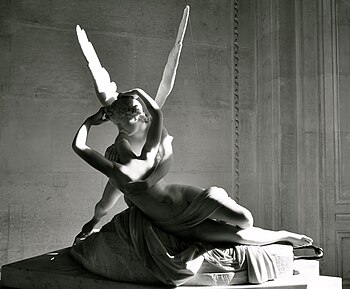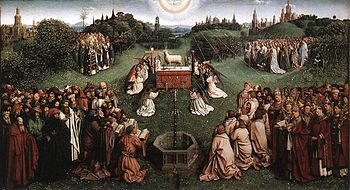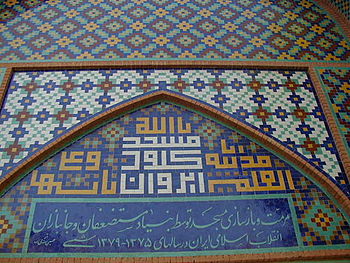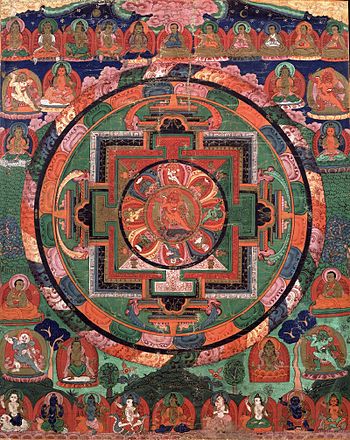Art Appreciation and Techniques/Module 8
The following is an initial page plan for this unit. The beginning text, before the colon, is the proposed page name. We will use the mytitle template to name the pages with a fuller title, as needed; the navigator will include just the one/two words for each:
- Overview: beginning through objectives
- Introduction: (to be written)
- Myth:
- Dreams:
- Spirituality:
- Summary: conclusion section
Other Worlds
In this module we see how art makes tangible things that inhabit the realm of human thoughts, beliefs and imagination. They include:
- Myths
- Dreams
- Spirituality
Objectives
- Identify art and ideas of the spirit.
- Describe how costume and decoration are used as vehicles for spirituality.
- Explain art as a form of myth.
- Describe the role of art in ritual and ceremony.
- Discuss connections among art, magic, and the idea of the fantastic.
Myth
Myth is defined as a usually traditional story of ostensibly historical events that serves to unfold part of the world-view of a people or explain a practice, belief, or natural phenomenon. They offer us explanations about the mysteries beyond the physical plane of our existence and that resonate within our own reality. Diverse examples of myth include the Christian story of David and Goliath, the Fairy Tale Beauty and the Beast and the genesis of the Asaro Mud Men in New Guinea.
In another example, Antonio Canova's statue Psyche Revived by Cupid's Kiss (below)commissioned in 1787, exemplifies the Neoclassic devotion to love and emotion. It represents the god Cupid in the height of love and tenderness, immediately after awakening the lifeless Psyche with a kiss. A masterpiece of its period, it appeals to the senses of sight and touch, but still alludes to the Romantic interest in emotion co-existing with Neoclassicism.
The myth associated with Saint Michael and the Dragon (below) is symbolized with the personification of goodness and evil represented by a winged serpent or reptile. St. Michael clearly has the upper hand here as he triumphs over Satan.
Dreams
The influence of dreams in art is significant. Shakespeare’s A Midsummer Night's Dream is an example in classical literature. Dreams provide creative subject matter for visual artists too, and play an additional role in art through ceremony and ritual.
In Western culture the dream’s place in art is most associated with the Surrealist movement in the early 20th century. But dream imagery was part of a larger frame of reference in the Romantic period beginning in the late 18th century. This style is characterized by its emphasis on emotion, dramatic composition and allegory.
Henry Fuseli’s The Nightmare (below) is a famous example of a Romantic painting that uses a dream as its subject. Fuseli shows both the dreaming figure sprawled on her bed and the visual contents of her dream in the form of an incubus sitting on her chest, a ghost – eyed horse (literally a nightmare
The Surrealist movement mentioned above was first centered in literature, expanding to the visual arts later on. The French poet and writer Andre Breton (1896-1966) was instrumental in the development of Surrealist ideas. Looking for new avenues to written expression, he investigated the subconscious mind’s ability to generate steams of ideas, words and phrases without necessarily making order out of them. The result was the use of automatic writing, or automatism. In the 1920’s artists Jean Miro, Hans Arp and Yves Tanguy began to use automatism as a means to generate visual ideas.
The Surrealist artists used dreams in a different context than the Romantics. Though a few Surrealists did use dream images as subject matter, the real emphasis was on automatism and the resulting image it helped create.
Surrealism was influenced in large part by new ideas in psychiatry and the clinical work of Sigmund Freud. The idea of repressed feelings, reflexive movements and past experiences interested the Surrealists very much. In the opening line of Breton’s Surrealist Manifesto he writes “Man, that inveterate dreamer, daily more discontent with his destiny…” and defines Surrealism as “psychic automatism in its pure state”.
In particular, Yves Tanguy’s paintings summon both automatism and dream-like imagery. In The Satin Tuning Fork from 1940 he sets precise biomorphic figures within a foggy, vacant landscape. The painting’s title has no apparent relation to the objects in the work, and itself is probably a result of automatism.
A ‘dream’ can also be a highly sought after goal or objective. Pablo Picasso alludes to this characterization in a series of etching prints titled The Dream and Lie of Franco from 1937. The artist’s portrayal of Franco as self-absorbed, tubular and abstract strengthens our view of him as monstrous. Together, the prints illustrate a narrative of the fascist Spanish general in scenes of battles and destruction during his rule in the Spanish Civil War. (This work can also be seen within the context ofWar discussed in module 7). Some of the individual prints in the series are studies for Picasso’s protest mural Guernica from the same year.
In a final example, Australian aboriginal culture relies on the dreamtime to provide explanations about the origins of the earth, their ancestors and the significance of ritual in their lives. These ideas are manifest in dream paintings: conventional abstract symbols painted on fields of color that signify connection to the dreamtime. This is part of the culture’s mythic foundation.
Spirituality
The art historical record is filled with works from many cultures that refer directly to spirituality. The following seven images are examples that help us understand how this connection is made.
Christian
Jan Van Eyck’s The Adoration of the Lamb (below) from the 15th century uses a variety of iconographic symbols to present the idea of Jesus Christ. Foremost is the lamb on the altar in the middle of the panel. Jesus proclaimed he is the “Lamb of God”, referring to the innocence and vulnerability of an infant sheep, but also to the one who will be sacrificed. Angels surround the lamb, the two in front swinging incense pots towards the altar. Blood gushes from the pierced breast of the animal, falling into a golden chalice. This reference is to the body and blood of Christ taking the form of bread and wine in the Christian Eucharist.
To the left of the altar is the cross, another symbol of Christ’s sacrifice. On the right is a column, signifying that he is the pillar of the church. The fountain in the foreground represents both the baptismal font and the symbol of Christ as the water of life. All of this plays out within a pastoral landscape replete with meadows, orchards, forests and, in the distance, a church steeple and town on a hill beyond. The circle of light at the top of the painting is generated by the Holy Spirit, which takes the form of a dove. Can you find more symbols? The symmetry of the composition is striking, and gives a strong sense of stability to the entire picture. The Adoration of the Lamb is one of the central panels from the twenty-four-panel Ghent Altarpiece.
Islamic
Because of our human imperfections, Islamic religious belief considers it a sin to present God (Allah) in human form. Instead, Islamic spiritual images use fluid calligraphy and extensive decoration. Below is a 17th century illustration with the name of God written within the middle circle, surrounded by gold flowers and ruby colored leaves in symmetrical geometric patterns. The whole image takes the form of an open flower or bright sun.
We see this tight geometric pattern again in a tile mosaic in a contemporary Islamic mosque (below). It’s significant to note that Arabic culture also gave the world its concepts of mathematics, geometry and astronomy. This style of illustration and embellishment has been used for centuries in Islamic cultures. You can refer back to Module 6: Architecture to see the decorative designs on the 5th century Dome of the Rock mosque in Jerusalem.
Buddhist
Buddhist spiritual iconography has comparisons and differences in relation to both Christian and Islamic styles. The main compositional format in Buddhist spiritual images is the use of a central mandala or circle. Tibetan mandala paintings show detailed decorative patterning similar to Islamic imagery, but anthropomorphize their gods and spirits much like Christianity does. The paintings are hierarchal, with each figure taking a place of status in relation to another.
You can see the striking visual effects Buddhist mandala paintings have in the example below. In the Five Deity Mandala, complimentary color sets of green and red, blue and orange create a visual tension that is balanced by the symmetry of the composition. In the center is Rakta Yamari, a Buddhist deity idealized with a fierce look, large eyes and flame-like hair. He embraces his consort Vajra Vitali. To the left and right of the large circle are four other gods, each embracing their own consort. They take the positions of the four directions: at the top right (west) is the red Raga Yamari. The bottom right (north) is green Irshya Yamari. The bottom left corner (east) is the white Moha Yamari and on the top left (south) is yellow Matsarya Yamari. Figures of lesser gods and gurus are placed throughout the composition. Notice the mandalas surrounding their heads. The Christian halo shares this significance.
The propensity for color and pattern in Buddhist spiritual art extends to the embellishments of their temples. The Dia Tang temple in Lynnwood, Washington is an example. Built in honor of the Ksitigarbha Bodhisattva, its architecture and landscape design shows Asian influences, with colorful paper lanterns, columns festooned with serpents and dragons and large statuary symbolic of Buddhist gods and bodhisattvas.
African
African cultures symbolize many spirits through costumes and masks used in ceremonies and rituals. The Ogbodo Enyi, or Elephant Spirit mask, has specific meaning to the Igbo people of northeastern Nigeria. The Ogbodo Enyi is often described as a harsh, violent spirit mask of unusual power. Men and boys from different age groups wear the mask and a heavy knit costume in highly charged performances. The masker, accompanied by musicians playing gongs and drums, “works himself into a frenzy, shaking and trembling. He suddenly bursts forth, running with long strides… charging through the village”.
The mask’s form is extremely angular and stylized. You can see the tusks at the bottom of the mask in the image below. The conical eyes and the elephant trunk (ilolo) jut out from the forehead. The ilolo is also a charm that protects the masker from his enemies. A human head (ntekpe) is carved in relief or fully round at the top of the mask, usually at the side or facing the back. This acts as a calming agent against the ferocious-looking elephant mask.
For all the ferocity and energy that goes into it, the Ogbodo Enyi performance is really a community exhibition of cohesiveness -- a public demonstration that different age groups can work towards common goals.
A short movie from a similar ceremony in Burkina Faso shows another spirit running and swirling through a crowd wearing a Bwa plank mask.
The human / animal form seen in Ogbodo Enyi is repeated in the Manua mask from New Guinea. A carved figure with a mask face stands on the head of a second larger mask. Surrounding them is a grid of fish, snakes and birds. The mask is believed to harbor spirits of local legends or ancestors and is used during a Malanggan, a ceremonial gathering associated with group funerals and initiation rites. The mask is worn at the end of the Malanggan to clear ceremonial grounds of taboos. Another mask is pictured below.
Conclusion
Humans use art to capture the form of ideas about worlds outside of our own. It’s often a vehicle for myth or how we understand and explain concepts of a spirit world. Cultures use iconography to symbolize abstract ideas like dreams, love, power and emotion, and call on the artist to create them. Art has significance in ritual and ceremony.







